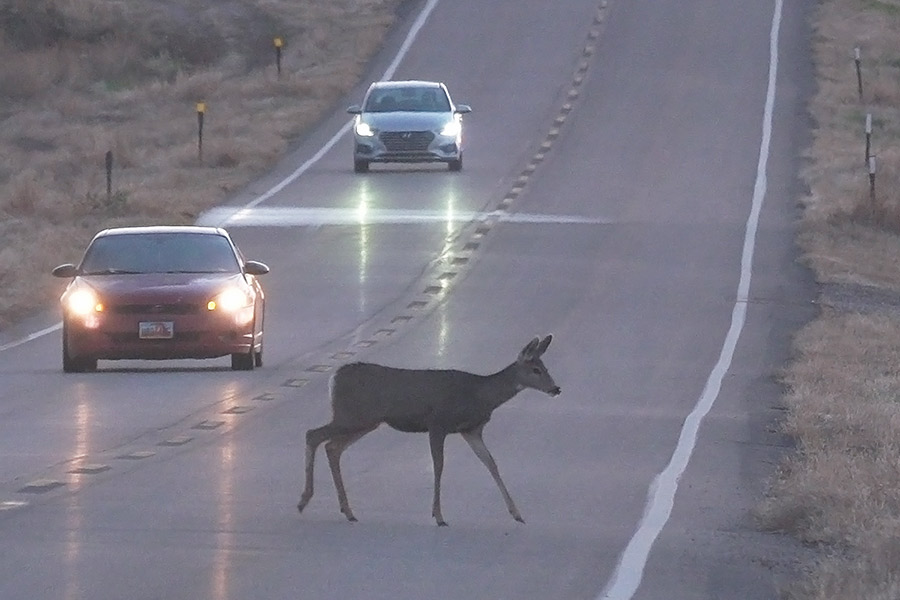Tips to avoid deer/vehicle collisions after daylight saving time ends Nov. 6
Salt Lake City — While Utahns will gain an extra hour of sleep on Nov. 6 when daylight saving time ends, the time change also means that many people will have evening commutes during lower-visibility hours in the months ahead, which can increase vehicle/wildlife collisions.
During the fall, there is an increase in wildlife along the roadways, primarily due to big game animals migrating to lower elevations in search of feed. The migration period for deer is typically April and May, and then again in October and November, which is also when the highest number of vehicle and deer collisions occur in Utah.
"The peak time to hit deer in Utah is during November," Utah Division of Wildlife Resources Migration Initiative Coordinator Blair Stringham said. "It coincides with mating season and the annual migration of deer. Animals are crossing more roads during the migration, and male deer move around a lot more to find mates. Plus, it doesn’t help that the daylight hours are shorter, creating lower visibility for drivers."
In 2012, there were approximately 10,000 deer-vehicle collisions, according to a DWR study. However, those numbers are likely lower now because more fences and wildlife bridges have been installed along migration routes across Utah highways in recent years, as part of the Utah Wildlife Migration Initiative.
The Utah Wildlife Migration Initiative was founded in 2017 to better track and study the migration patterns of different wildlife and fish species in the state. Most of the data comes from animals wearing GPS tracking devices or from fish tagged with implanted transmitters. Utah is currently the only state that includes fish tracking in its migration initiative. The tracking data benefits wildlife in several ways because biologists can identify where the animals spend large portions of time feeding and then make habitat improvements in those areas. The data is also used to locate migration routes and ensure that wildlife crossings are constructed strategically (i.e., where those routes cross highways or rivers).
So far this year, there have been over 4,000 deer/vehicle collisions reported in Utah. Deer are more active early in the morning and in the evenings, which coincides with busy commuting hours. This is also when low-light conditions make it difficult for drivers to see.
How to avoid wildlife collisions
As daylight saving time ends, here are some tips from Wild Aware Utah to help you avoid wildlife collisions:
- Be especially alert at dawn and dusk.
- Heed wildlife crossing signs. These signs are usually placed in areas known to have a high volume of wildlife/vehicle collisions.
- Be alert on roadways near wooded, agricultural and wetland areas and also near lakes and streams.
- Scan both sides of the road as you drive. Invite passengers to help watch for wildlife.
- Do not drive distracted. Put away food, phones and other distractions.
- When possible, use high-beam headlights to better illuminate the road.
- Look for an animal's eyeshine, which can be seen from a distance. Slow down once you have spotted an animal near the roadside.
- Some animals travel in groups, so be sure to watch for additional animals if you see one.
- Do not throw trash out of your vehicle. Not only are there penalties for littering on a highway, but trash and food scraps can also draw animals to roadways.
What to do if you see an animal on or near the road
If you see an animal on or near the road, here are some additional suggestions:
- Do not swerve for a deer or small animals. Stay in your lane and slow down.
- If several animals are standing in the road, do not try to drive through them or get out of the vehicle to chase or herd them. Honk your horn and flash your lights to encourage them to move on.
- If an animal has crossed the road, continue to drive slowly and be cautious because it may try to cross again.
What to do if you hit an animal
- Pull off the road and use your hazard lights if your car is undriveable.
- Do not try to approach an injured animal.
- Call 911 or contact your local police department if you were injured or if the animal is in the roadway and could pose a threat to public safety.

















